India is not only home to a diverse variety of language, food, music, or fashion but also a spectrum of architectural styles. For ages, a unique style of temple-construction and terracotta decoration thrived in Bengal. Generally smaller in size than the rest of India and scattered all over the lower Gangetic delta, typical Bengali temples represent a unique chapter in the annals of Indian architecture. The curved arches, the beautiful pinnacles, the detailed terracotta panels– all adding to the sublime serenity of Bengal temples. Situated at the eastern side of the Indian subcontinent, the Bengal delta is the alluvial plain formed by innumerable rivers. So, lower Bengal always faced a scarcity of stones, one of the basic materials used for temple construction throughout India. But the absence of stones did not deter this part of Bengal from developing a unique style of temple construction. The scarcity of stones, being replaced by terracotta works, has given birth to various brick-made temple-styles as well as intrinsic artworks.

(SungaWithChild – Chandraketugarh – Wikipedia)
Historically, the earliest known instances of terracotta panels come from Chandraketugarh (generally dated to 300 BCE—300 CE). We have quite a few examples from Paharpur-Mainamati and other areas in Eastern Bengal after that, but this art form disappeared for a while before reappearing in the second millennium. Bengali architects and artists since the 10th century, when the first of the Bishnupur temples was built, made wonderfully innovative use of terracotta to build temples and other structures (terracotta panels were used in large numbers in mosques built in Central Bengal between 13th and 16th century). In case of Bishnupur, an entire temple town was built using clay and brick, adorned with intricate artworks of terracotta panels.
Shikhar Style
Apart from materials used, architecturally too, Bengal temples stand out for their unique styles. A historical journey may help in decoding such style quotients:
Shikhara Style
Shikhara temples have a tall, rising tower above the sanctuary of the deity, which may be ridged or smooth. Commonly, the tower has curvilinear walls that meet at the peak. Methodologically this style has lots of similarities to the architecture of many other temples in India, especially in Odisha. According to historians, this style emerged in the Buddhist Pala era in the 9th-10th century. Although in later times the temples were used for worshipping Hindu deities, in some of these temples, Jain or Buddhist icons are seen alongside. In the districts of Bankura-Purulia-Midnapore, situated in the south-west part of Bengal, Shikhara temples are prevalent.


Ratna-Style
This is one of Bengal’s very own styles. Ratna is basically a pinnacle situated on top of the curved cornices of the temple-house.
- When there is only one, central pinnacle over the cornice, it is called ek-ratna.
- If there are four smaller pinnacles alongside the main, central pinnacle it will be referred as pancha-ratna.
- Sometimes, the central pinnacle is replaced by pancha-ratna pseudo-storey, to make it a nava-ratna temple.
- Other than these main tropes, temples with thirteen, seventeen, twenty-one and even twenty-five pinnacles are seen rarely.

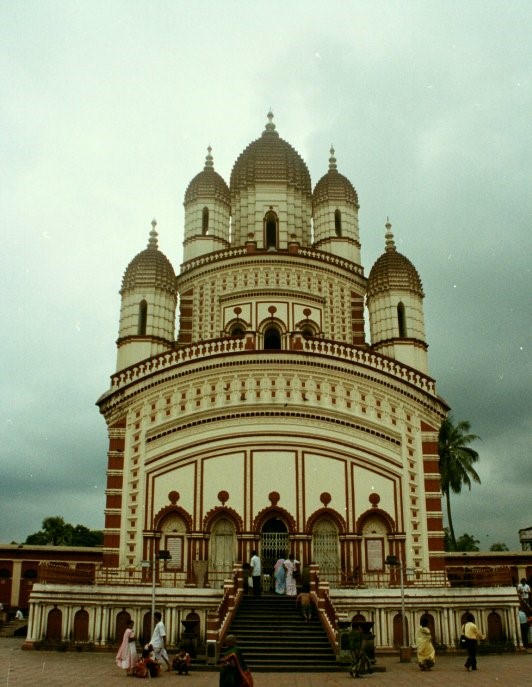
The Gaudiya Vaishnava Bhakti movement initiated by Chaitanya, reached Bishnupur by the end of the 16th century through a fascinating incident. Vaishnava Scholars of Vrindaban had sent some important manuscripts to Bengal, when they were looted by the gang of Bir Hambir, the then king of Bishnupur. After a few days, Shrinibas Acharya, a saintly preacher, came looking for it. When he managed to reach the court and got a chance to comment on the sacred Bhagavata– the king was mesmerised. He became a disciple at once. Not only did he return the manuscripts but also he devoted all his energy in promoting Vaishnava bhakti. During his lifetime he established many temples including the magnificent Rasmancha. His descendants, too, kept building temples unique in style and decoration for centuries. Bishnupur for centuries remained a vibrant centre of Vaishnava bhakti, classical music and a variety of unique handicrafts.
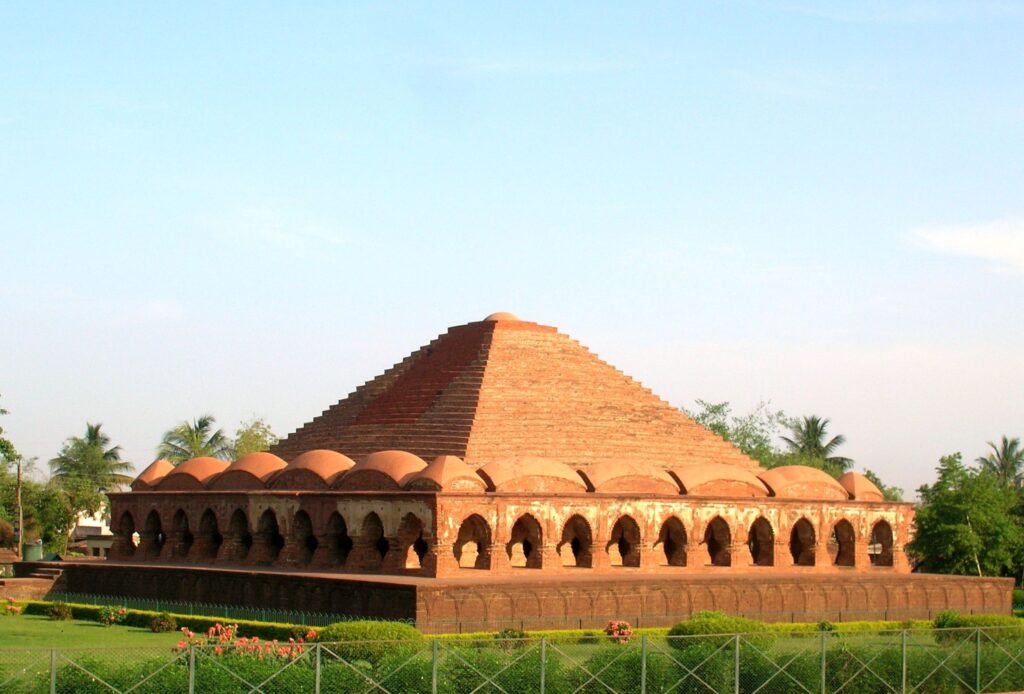
Chala Style
In every village of Bengal, huts made of clay and hay with minimal effort are found. During the 15-16th century, this folk-style was assimilated into temple architecture. Two or four roofs meeting in a line or point makes a chala temple.
- Dochala/Ek-Bangla temples have two sloping, curved roofs meeting in a straight line.
- Two Ek-Bangla temples fused at their sides form a Jor-Bangla temple. They have two conjoined curved roofs.
- A hut-like structure with four curved roofs meeting at the top is called Charchala, or four roofed temples.
- The Atchala is an extension of the Charchala form, where above the four-roofed structure, a short cuboid tower supports another, smaller four-roofed structure.



Decorations
Bengal temples are comparatively smaller than the ones in Southern or Western India. But still what always attracts the eye is the precedence of curved lines (in the shape of the temples), which is both geometrically and architecturally considered to be the finest. Yet, the beauty of Bengal temple does not lie only in temple structures, but also in its decorative works. Almost all temple-walls of mediaeval Bengal were decorated by terracotta panels. From the mythical narratives to details of contemporary social life– various aspects are embodied in the intricacies of the panels.
Mythical Narratives
- Narratives from both Ramayana and Mahabharata have been used frequently to decorate temple-walls. Most of the late mediaeval temples have a panel depicting war between Rama and Ravana, just above the curved entrance. Bengal had a rich association with Ramayana in the pre-colonial era. Many poets translated Ramayana in the vernacular language of which stand first the Krittivasi Ramayan by Krittivas Ojha. The terracotta panels depict a visual representation of the same.
- The Gaudiya Vaishnava Bhakti movement had quite an impact on Bengal temples. Tales of Bhagavat Puran along with the sensual love stories of Radha-Krishna were largely used in decorative works. The Rasmandal stands for a divine Krishna-verse, where Krishna is at the centre of everything, surrounded by his beloved Gopis.
- The Gaudiya Vaishnava Bhakti movement had quite an impact on Bengal temples. Tales of Bhagavat Puran along with the sensual love stories of Radha-Krishna were largely used in decorative works. The Rasmandal stands for a divine Krishna-verse, where Krishna is at the centre of everything, surrounded by his beloved Gopis.

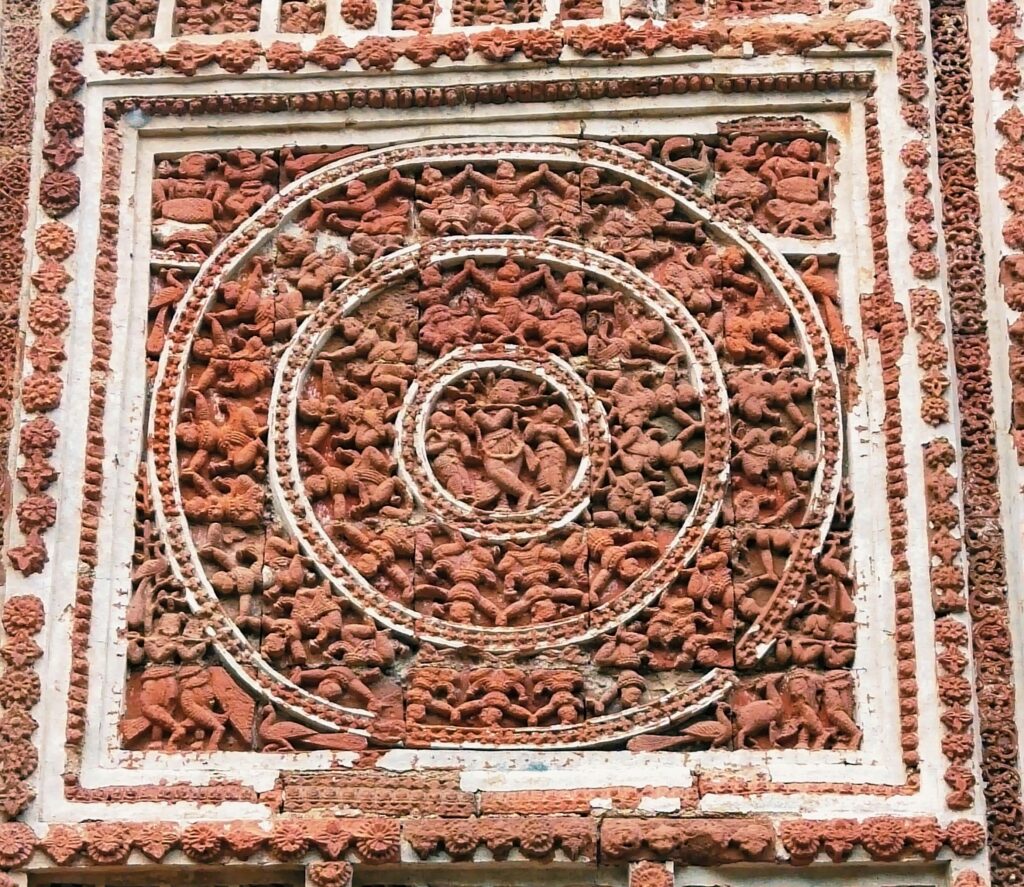

Social Reality
Along with music and dance, various cultural practices, social rituals, and lives of people from different social stratas of Bengal and even the presence of Europeans have found reflections in the terracotta panels. Because of the Portuguese, Hooghly had emerged as a global port from the beginning of the 15th century, where the trade and commerce of three different continents would mingle. But the activities of the Portuguese often would not stop just in peaceful trades as they were active participants in slave trade. People were frightened by them, and clashes were common until 1632, when the Mughal Emperor Shah Jahan detracted the power and dominance of the Portuguese by a military expedition. The memory of bloodshed didn’t erase quickly from the collective memory of Bengalis. They named the Portuguese as Bombete (derived from Bombardeiro) because of the cannon-loaded warships that they used to bombard. Many temple walls, especially those around the river Hooghly, depict these Portuguese warships.
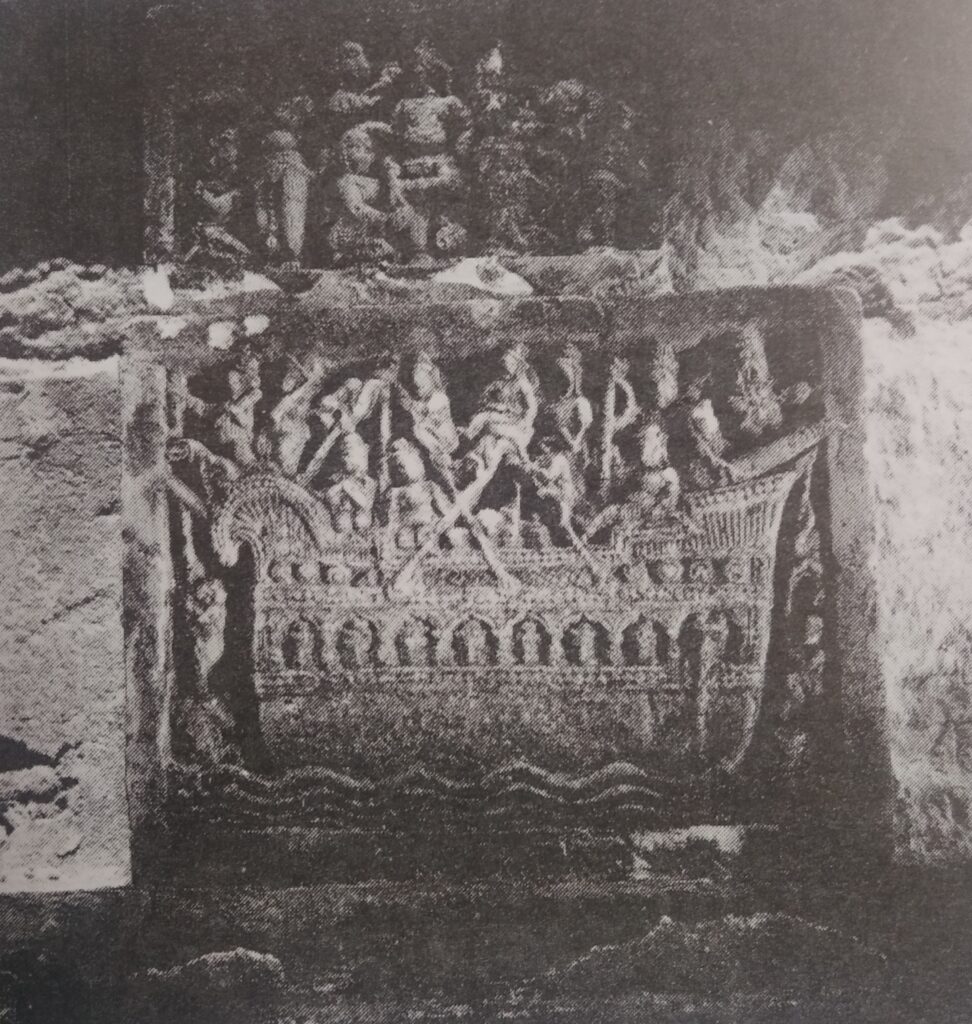
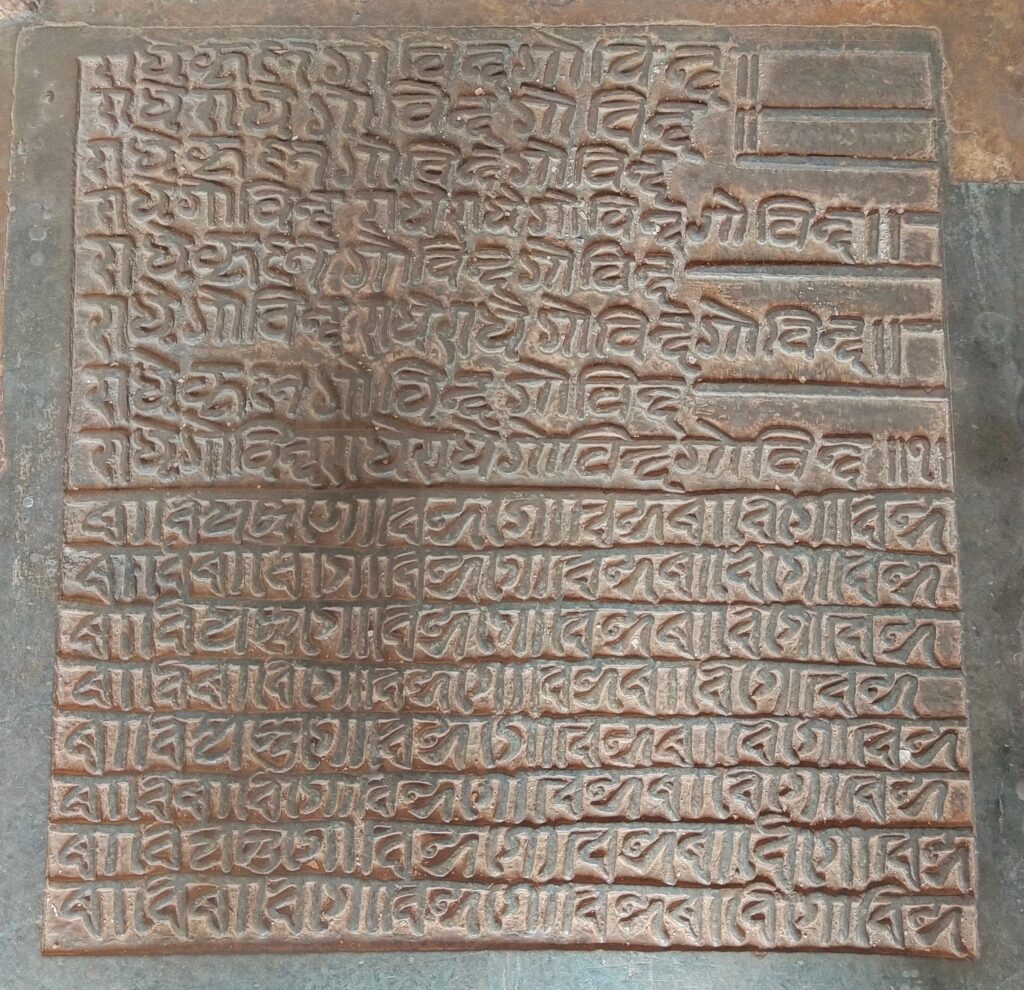
Further studies
On Bishnupur terracotta temples,
https://artsandculture.google.com/story/bishnupur-temples-of-the-earth-live-history-india/ZAVRvGAtAGf0Lw?hl=en
Since the beginning of the last century, temple-architecture of Bengal has been attracting enthusiasts in and abroad. Hiteshranjan Sanyal and David McCutchion, both professors, started their research in the 60s. Recently the Centre for Studies in Social Sciences, Calcutta has digitised the photographs taken by Mr. Sanyal and made them public. (Religious Architecture of Bengal – Digital Archive of Photographs from the Hitesranjan Sanyal Collection at The CSSSC (cssscal.org)) Amiya Kumar Bandyopadhyay and Tarapada Santra are two more stalwart figures in the same field.
The enthusiasm regarding temples has escalated successively ever since. At present a lot of people, both travellers and researchers, are writing blogs on temples in and around Bengal. Two of such blogs are following- Rangan Datta, Freelance Travel Writer & Photographer (rangan-datta.info) Amitabha Gupta – Photographer & Travelogue Writer (wordpress.com)
Most of the beautiful temples are not far away from Kolkata. A short one-day trip is enough to cover more than one spot. Here is a brief travel guide:
| Place (Driving distance from Kolkata) | Trains | What to see |
| Bishnupur (140 km) | Trains are available from Howrah station to Bishnupur that take about 3 hours. | Rasmancha, Jor-bangla, Shyam-rai, Kalachand, Radha Govinda, Lalji, Lalbandh etc. |
| Ambika-Kalna (90 km) | From Howrah, it takes only 1.5 hours to reach Ambika-Kalna by train | Mahaprabhu Temple, 108 at-chala temple, Pratapeshwar, Lalji and Krishna Chandra temple |
| Guptipara (85 km) | On the Howrah-Katwa train line, it takes 2 hours from Howrah. | Vrindavan Chandra temple, Chaitanya temple, Krishnachadra temple, Ramchandra temple |
| Bansberia (55 km) | Bansberia (55 km) | Hamseshwari temple, Ananta-Basudeb temple |